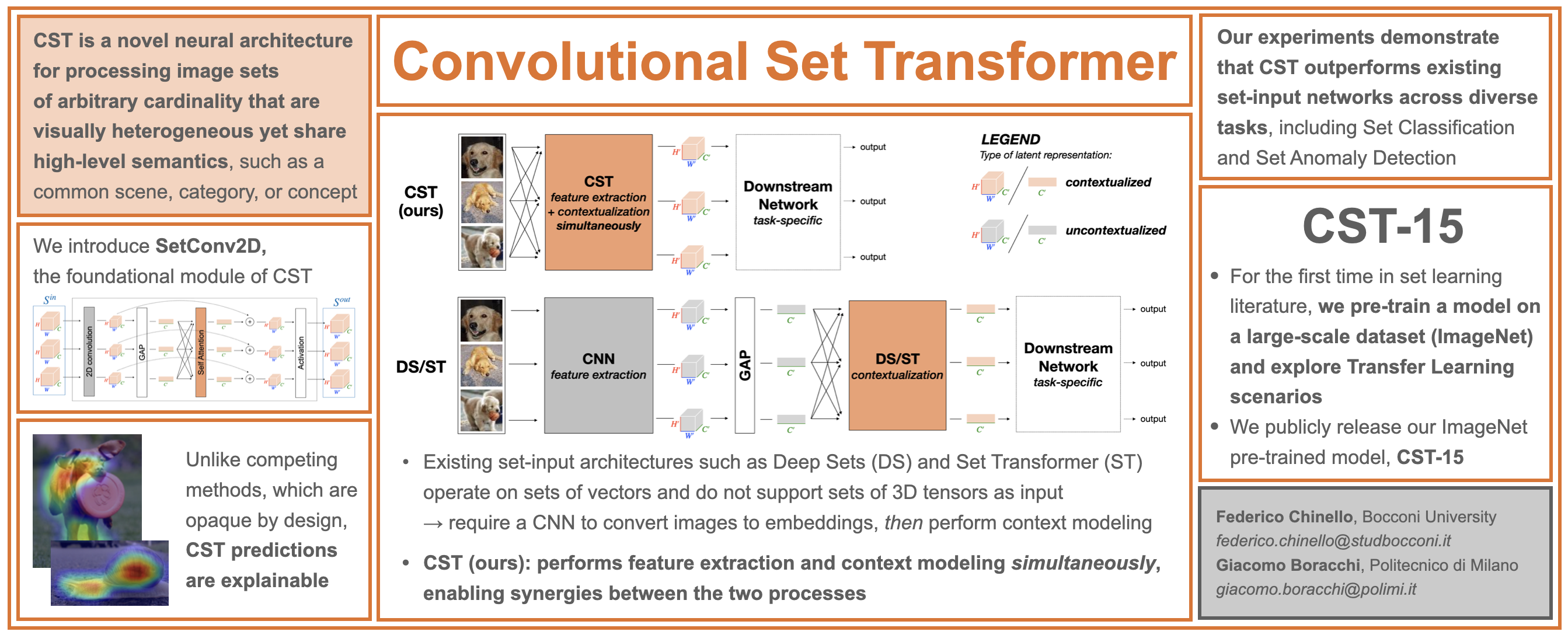Convolutional Set Transformer (cstmodels)
The cstmodels package provides the reference implementation of the Convolutional Set Transformer (Chinello & Boracchi, 2025). It includes reusable Keras 3 layers for building CST architectures, and provides an easy interface to load and use CST-15, the first set-learning backbone pre-trained on ImageNet.
If you have any questions or concerns, please feel free to contact me at federico.chinello@studbocconi.it.
About CSTs

Highlights:
- CST is a novel deep learning architecture for processing image sets of arbitrary cardinality that are visually heterogeneous yet share high-level semantics (e.g., a common category, scene, or concept).
- CST is general-purpose and supports a broad range of applications, including set-based classification tasks and Set Anomaly Detection.
- In the domain of image-set processing, CST outperforms existing set-learning approaches such as Deep Sets and Set Transformer. Unlike these methods, which are inherently opaque, CST is fully compatible with standard CNN explainability tools, including Grad-CAM.
- While Deep Sets and Set Transformer are typically trained from scratch, CST supports Transfer Learning: it can be pre-trained on large-scale datasets and then effectively adapted to diverse downstream tasks. We publicly release CST-15, the first set-learning backbone pre-trained on ImageNet.
Want to dive deeper? Check out our paper!

Unlike Deep Sets and Set Transformer, which are inherently opaque, CST is fully compatible with standard CNN explainability tools. The Figure above shows Grad-CAM overlays for an image set provided as input to CST-15, with respect to the ground-truth class.
Installation
You can install the latest release of cstmodels from PyPI:
pip install cstmodels
Loading CST-15
Instantiate CST-15 with or without pre-trained ImageNet weights:
from cstmodels import CST15
model = CST15(pretrained=True)
Building a CST from scratch
The package provides the tools needed to build a Convolutional Set Transformer from the ground up, including:
- SetConv2D: the reference implementation of the SetConv2D block introduced in Chinello & Boracchi, 2025.
- SmartReshape2D: a utility layer that reshapes tensors depending on whether a set dimension is present. It automatically converts between
(batch, set_size, H, W, C)→(batch*set_size, H, W, C)(batch*set_size, H, W, C)→(batch, set_size, H, W, C)
This is useful when switching between layers that operate per-image and those that require an explicit set structure.
from keras import layers
from cstmodels import SetConv2D, SmartReshape2D
def CST():
input_layer = layers.Input(shape=(None, None, None, 3))
# Input is: (batch_size, set_size, heigh, width, channels)
# We reshape to: (batch_size * set_size, heigh, width, channels)
x, set_size = SmartReshape2D()(input_layer)
x = SetConv2D(32, 3, activation='relu', padding='same')(
x, set_size=set_size
)
x = SetConv2D(32, 3, activation='relu', padding='same')(
x, set_size=set_size
)
x = layers.MaxPooling2D()(x)
x = SetConv2D(64, 3, activation='relu', padding='same')(
x, set_size=set_size
)
x = SetConv2D(64, 3, activation='relu', padding='same')(
x, set_size=set_size
)
x = layers.MaxPooling2D()(x)
x = SetConv2D(128, 3, activation='relu', padding='same')(
x, set_size=set_size
)
x = SetConv2D(128, 3, activation='relu', padding='same')(
x, set_size=set_size
)
x = layers.MaxPooling2D()(x)
x = layers.GlobalAveragePooling2D()(x) # -> (batch_size * set_size, channels)
output_layer = layers.Dense(units=10, activation='softmax')(x)
model = keras.Model(inputs=input_layer, outputs=output_layer)
return model
model = CST()
Tutorial Notebooks
We provide two self-contained tutorials notebooks here:
cst_from_scratch.ipynbdemonstrates how to build and train a CST from scratch on the CIFAR-10 dataset;cst15_transfer_learning.ipynbillustrates how to adapt the pre-trained CST-15 backbone to new tasks, using colorectal histopathology images as a case study for Transfer Learning.
Citation
If you use this package in your research, please cite:
@misc{chinello2025convolutionalsettransformer,
title={Convolutional Set Transformer},
author={Federico Chinello and Giacomo Boracchi},
year={2025},
eprint={2509.22889},
archivePrefix={arXiv},
primaryClass={cs.CV},
url={https://arxiv.org/abs/2509.22889},
}